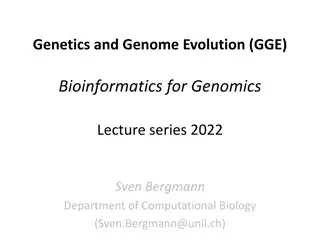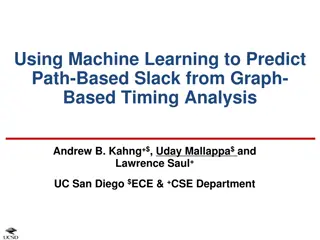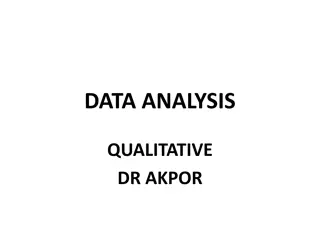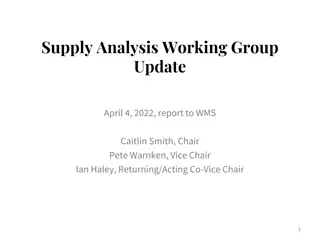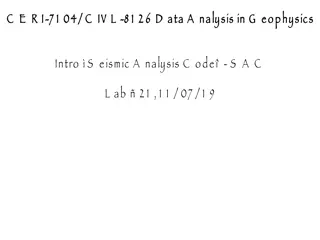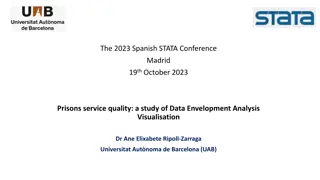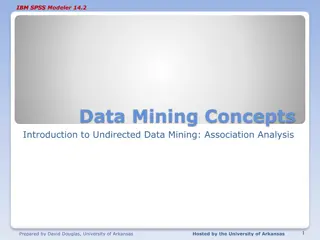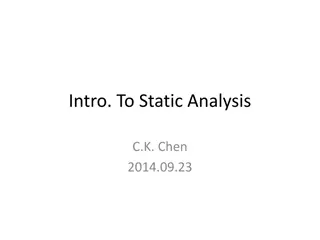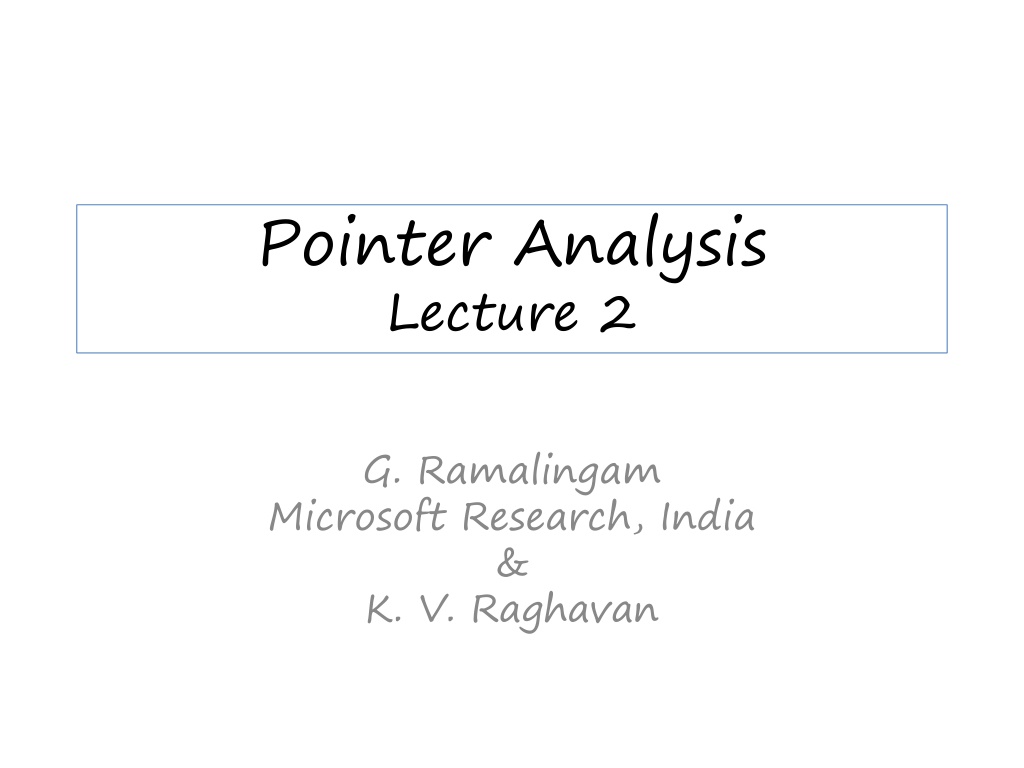
Precise Points-To Analysis and Computational Complexity
Explore the correctness and precision of algorithms, Abstract Interpretation, approximating transformers, and the computability of precise solutions in pointer analysis lecture notes. Learn about the computational complexity of least-fixed point computation using collecting semantics and the challenges in computing precise may-point-to relations, even with two-level pointers.
Download Presentation

Please find below an Image/Link to download the presentation.
The content on the website is provided AS IS for your information and personal use only. It may not be sold, licensed, or shared on other websites without obtaining consent from the author. If you encounter any issues during the download, it is possible that the publisher has removed the file from their server.
You are allowed to download the files provided on this website for personal or commercial use, subject to the condition that they are used lawfully. All files are the property of their respective owners.
The content on the website is provided AS IS for your information and personal use only. It may not be sold, licensed, or shared on other websites without obtaining consent from the author.
E N D
Presentation Transcript
Pointer Analysis Lecture 2 G. Ramalingam Microsoft Research, India & K. V. Raghavan
Correctness and precision of Algorithm A
Enter: The French Recipe (Abstract Interpretation) AbstractDomain Asemi-lattice(A, ) TransferFunctions For every statement st, AS[st] : A -> A Concrete (Collecting) Domain Asemi-lattice(C, ) TransferFunctions For every statement st, CS [st] : C -> C C 2DataState A AbsDataState
Points-To Analysis (Abstract Interpretation) (Y) = \p. {x | exists s in Y. s(p) == x } (a) = {s | for each pointer variable p, s(p) a(p)}
Approximating Transformers: Correctness Criterion It can be shown that for any statement st, and for any a1 A AS[st](a1) (CS[st]( (a1))
Correctness illustration x: &y y: &x z: &a x: {&y} y: {&x,&z} z: {&a} x: &y y: &z z: &a CS *y = &b; *y = &b; AS x: &b y: &x z: &a x: {&y,&b} y: {&x,&z} z: {&a,&b} x: &y y: &z z: &b
Is The Precise Solution Computable? Claim: The set RS(u) of reachable concrete states (for our language) is precisely computable. (However, Algorithm A is imprecise) Note: This is true for any collecting semantics with a finite state space. This is true only for restricted language!
Precise Points-To Analysis: Computational Complexity What s the complexity of the least-fixed point computation using the collecting semantics? The worst-case complexity of computing reachable states is exponential in the number of variables. Can we do better? Theorem: Computing precise may-point-to is PSPACE-hard even if we have only two-level pointers.
Precise Points-To Analysis: Caveats Theorem: Precise may-alias analysis is undecidable in the presence of dynamic memory allocation. Add x = new/malloc () to language State-space becomes infinite Digression: Integer variables + conditional-branching involving integer variables also makes any precise analysis undecidable.
Dynamic Memory Allocation s: x = new () / malloc () Assume, for now, that allocated object stores one pointer s: x = malloc ( sizeof(void*) ) Introduce a pseudo-variable Vs to represent objects allocated at statement s, and use previous algorithm treat s as if it were x = &Vs also track possible values of Vs allocation-site based approach
in the presence of pseudo variables (Y) = \p. {x | exist s in Y such that s(y) = z such that: ((p is a normal variable and y is p) OR (p is Vr and y is an address allocated at site r )) AND ((x is a normal variable and x is z) OR (x is Vt and z is an address allocated at site t )) } (For simplicity, assume that the set of all concrete addresses is partitioned upfront among all allocation sites in the program)
in the presence of pseudo variables (a) = {s | normal variables p: s(p) = x x is a normal variable x a(p), OR s(p) = y y is an address allocated at site t Vt a(p), AND pseudo-variables Vr: addresses y allocated at Vr: s(y) = x x is a normal variable x a(Vr), OR s(y) = z z is an address allocated at site t Vt a(Vr)}
Dynamic Memory Allocation: A run of the algorithm 1 x = new; // 1 x -> {V1}, y -> {null}, V1 -> {null} 2 y = x; x -> {V1}, y -> {V1}, V1 -> {null} 3 *y = &b; x -> {V1}, y -> {V1}, V1 -> {null,b} 4 x -> {V1}, y -> {V1}, V1 -> {null,a,b} *y = &a; 5
Illustrating need for weak updates on pseudo variables Key aspect: Vs represents a set of memory locations, not a single location if x->{Vs}, to be safe *x = .. still needs weak update! Consider this program: do {x = new /* V1 */; *x = &a} while(..); *x = &b; Exercise: Say in the last stmt above we set V1 -> {b}. Show that \gamma(V1 -> {b}) does not include all concrete states that can arise at the end of the program.
Inter-procedural analysis Context-sensitivity can be achieved using standard techniques Indirect (virtual) function call sites need to be resolved to candidate functions using points-to analysis. And points-to analysis needs calls to be resolved! Therefore, the two have to happen hand in hand.
Andersens Analysis A flow-insensitive analysis computes a single points-to solution, which over-approximates points-to solutions at all program points ignores control-flow treats program as a set of statements equivalent to collapsing the given program to have a single program point, and then applying Algorithm A on it.
Andersens Analysis If program has statements s1, s2, , sn, then create collapsed CFG as follows: Initial fact Single program point that Kildall updates s1 s2 sn After algorithm terminates, final solution at the single program point over-approximates result computed by flow-sensitive analysis at any point
Example: Andersen s Analysis x = &a; *x = &w; Before first iteration: all variables null After first iteration of Kildall: y = x; x -> {a,b,null}, y -> {a, null}, z -> {a,b,null}, all other variables null x = &b; After 2nd iteration: x -> {a,b,null}, y,z -> {a,b,null}, a,b -> {w,t,null}, all other variables null *x = &t; After 3rd iteration: X -> {a,b,null}, y,z -> {a,b,null}, a,b -> {w,t,null}, all other variables null z = x;
Notes about Andersens Analysis Strong updates never happen in Andersen s analysis! If x->{y} and y->{w} before we process statement *x = &z , then even if transfer function returns y->{z}, due to subsequent join, y will point to {w,z} after this step. Flow-insensitive style can be adopted for any analysis, not just for pointer analysis
Why Flow-Insensitive Analysis? Reduced space requirements a single points-to solution Reduced time complexity no copying of points-to facts individual updates more efficient a cubic-time algorithm Scales to millions of lines of code most popular points-to analysis
Andersens Analysis: An alternative formulation Introduce a constraint variable PTx for each program variable x Create a constraint from each assignment statement, as follows: x = y: PTy PTx *x = y: PTy PTv, forall variables v in PTx x = &y: {y} PTx x = *y: PTv PTx, forall variables v in PTy Find least solution to set of all constraints that were generated above. (A solution is a mapping from constraint variables to sets of program variables.) Emit this least solution as the final solution. Note: Solution s1 dominates Solution s2 if for each program variable v, s2(PTv) s1(PTv) Note: This approach computes exact same result as previous approach that collapses program and then uses Algorithm A. 1. 2. 3.
May-Point-To Analyses Ideal-May-Point-To more efficient / less precise Algorithm A more efficient / less precise Andersen s
Andersens Analysis: Further Optimizations and Extensions Fahndrich et al., Partial online cycle elimination in inclusion constraint graphs, PLDI 1998. Rountev and Chandra, Offline variable substitution for scaling points-to analysis, 2000. Heintze and Tardieu, Ultra-fast aliasing analysis using CLA: a million lines of C code in a second, PLDI 2001. M. Hind, Pointer analysis: Haven t we solved this problem yet?, PASTE 2001. Hardekopf and Lin, The ant and the grasshopper: fast and accurate pointer analysis for millions of lines of code, PLDI 2007. Hardekopf and Lin, Exploiting pointer and location equivalence to optimize pointer analysis, SAS 2007. Hardekopf and Lin, Semi-sparse flow-sensitive pointer analysis, POPL 2009.
Context-Sensitivity Etc. Liang & Harrold, Efficient computation of parameterized pointer information for interprocedural analyses. SAS 2001. Lattner et al., Making context-sensitive points-to analysis with heap cloning practical for the real world, PLDI 2007. Zhu & Calman, Symbolic pointer analysis revisited. PLDI 2004. Whaley & Lam, Cloning-based context-sensitive pointer alias analysis using BDD, PLDI 2004. Rountev et al. Points-to analysis for Java using annotated constraints. OOPSLA 2001. Milanova et al. Parameterized object sensitivity for points-to and side-effect analyses for Java. ISSTA 2002.
Applications Compiler optimizations Verification & Bug Finding use in preliminary phases use in verification itself







